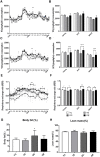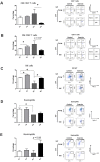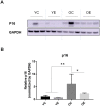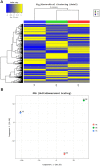Exercise reduces metabolic burden while altering the immune system in aged mice
- PMID: 33406502
- PMCID: PMC7834985
- DOI: 10.18632/aging.202312
Exercise reduces metabolic burden while altering the immune system in aged mice
Abstract
Although several evidence has suggested the impact of exercise on the prevention of aging phenotypes, few studies have been conducted on the mechanism by which exercise alters the immune-cell profile, thereby improving metabolism in senile obesity. In this study, we confirmed that 4-week treadmill exercise sufficiently improved metabolic function, including increased lean mass and decreased fat mass, in 88-week-old mice. The expression level of the senescence marker p16 in the white adipose tissue (WAT) was decreased after 4-weeks of exercise. Exercise induced changes in the profiles of immune-cell subsets, including natural killer (NK) cells, central memory CD8+ T cells, eosinophils, and neutrophils, in the stromal vascular fraction of WAT. In addition, it has been shown through transcriptome analysis of WAT that exercise can activate pathways involved in the interaction between WAT and immune cells, in particular NK cells, in aged mice. These results suggest that exercise has a profound effect on changes in immune-cell distribution and senescent-cell scavenging in WAT of aged mice, eventually affecting overall energy metabolism toward a more youthful state.
Keywords: NK cell; aging; exercise; immunosenescence; metabolism.
Conflict of interest statement
Figures






Similar articles
-
Intermittent fasting promotes rejuvenation of immunosenescent phenotypes in aged adipose tissue.Geroscience. 2024 Jun;46(3):3457-3470. doi: 10.1007/s11357-024-01093-4. Epub 2024 Feb 21. Geroscience. 2024. PMID: 38379117 Free PMC article.
-
Cold-induced lipid dynamics and transcriptional programs in white adipose tissue.BMC Biol. 2019 Sep 17;17(1):74. doi: 10.1186/s12915-019-0693-x. BMC Biol. 2019. PMID: 31530289 Free PMC article.
-
Exercise Prevents Diet-Induced Cellular Senescence in Adipose Tissue.Diabetes. 2016 Jun;65(6):1606-15. doi: 10.2337/db15-0291. Epub 2016 Mar 16. Diabetes. 2016. PMID: 26983960 Free PMC article.
-
Biochemical adaptations in white adipose tissue following aerobic exercise: from mitochondrial biogenesis to browning.Biochem J. 2020 Mar 27;477(6):1061-1081. doi: 10.1042/BCJ20190466. Biochem J. 2020. PMID: 32187350 Review.
-
Looking on the "brite" side exercise-induced browning of white adipose tissue.Pflugers Arch. 2019 Mar;471(3):455-465. doi: 10.1007/s00424-018-2177-1. Epub 2018 Jul 7. Pflugers Arch. 2019. PMID: 29982948 Review.
Cited by
-
Beyond the Finish Line: The Impact and Dynamics of Biomarkers in Physical Exercise-A Narrative Review.J Clin Med. 2021 Oct 27;10(21):4978. doi: 10.3390/jcm10214978. J Clin Med. 2021. PMID: 34768497 Free PMC article. Review.
-
Stem cell secretome treatment improves whole-body metabolism, reduces adiposity, and promotes skeletal muscle function in aged mice.Aging Cell. 2024 Jun;23(6):e14144. doi: 10.1111/acel.14144. Epub 2024 Mar 18. Aging Cell. 2024. PMID: 38500398 Free PMC article.
-
Exercise sustains the hallmarks of health.J Sport Health Sci. 2023 Jan;12(1):8-35. doi: 10.1016/j.jshs.2022.10.003. Epub 2022 Oct 29. J Sport Health Sci. 2023. PMID: 36374766 Free PMC article. Review.
-
Potential involvement of neutrophils on exercise effects in breast cancer malignancy.Phys Act Nutr. 2023 Dec;27(4):41-47. doi: 10.20463/pan.2023.0036. Epub 2023 Dec 31. Phys Act Nutr. 2023. PMID: 38297475 Free PMC article.
-
The effect of voluntary exercise on light cycle stress-induced metabolic resistance.Phys Act Nutr. 2023 Sep;27(3):1-9. doi: 10.20463/pan.2023.0022. Epub 2023 Sep 30. Phys Act Nutr. 2023. PMID: 37946440 Free PMC article.
References
-
- Santanasto AJ, Goodpaster BH, Kritchevsky SB, Miljkovic I, Satterfield S, Schwartz AV, Cummings SR, Boudreau RM, Harris TB, Newman AB. Body composition remodeling and mortality: the health aging and body composition study. J Gerontol A Biol Sci Med Sci. 2017; 72:513–19. 10.1093/gerona/glw163 - DOI - PMC - PubMed
Publication types
MeSH terms
LinkOut - more resources
Full Text Sources
Other Literature Sources
Medical
Research Materials

